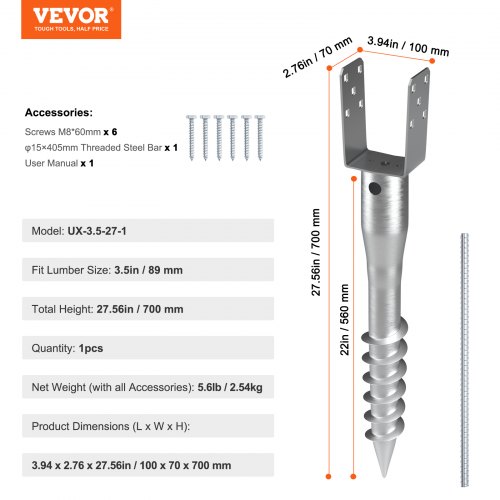How Heavy-Duty Earth Anchors Work: A Comprehensive Overview to Dirt Anchoring Solutions
Durable Earth anchors play an essential function in providing stability and support in various building and construction applications. By embedding deeply right into the ground, they stand up to upright and side pressures efficiently. Different sorts of supports satisfy various soil problems, making them flexible. Understanding their mechanics and installment techniques is crucial for optimizing efficiency. What factors affect their performance, and just how do they compare to typical methods? The solutions might shock you.
Recognizing Sturdy Earth Anchors
Sturdy Earth anchors act as vital elements in numerous building and landscape design projects, giving stability and support in challenging dirt problems. These supports function by being embedded right into the ground, where they resist upright and side pressures. Their style enables secure accessory to structures, guaranteeing they stay anchored against dirt movement or outside loads.The performance of heavy-duty Earth anchors greatly relies on the kind of soil and the support's installation deepness. Correct installation methods are essential, as they figure out the anchor's holding capacity. Ecological aspects, such as dampness and freeze-thaw cycles, can additionally affect performance.These anchors are often made use of in applications varying from securing fencings and preserving walls to stabilizing temporary structures during damaging weather. Recognizing the principles behind sturdy Earth supports is vital for professionals seeking to enhance the longevity and safety of their tasks.
Kinds Of Heavy-Duty Earth Anchors
Numerous types of heavy-duty Earth supports are designed to meet particular needs based on soil problems and project requirements. Helical supports, featuring screw-like blades, work in softer soils, providing high tons abilities and easy installment. Driven supports, which are inculcated the ground, are appropriate for rough surfaces and provide instant load support. Tie-back anchors are commonly used in retaining wall applications, permitting for lateral support by securing into the ground at an angle. Another kind is the cast-in-place support, ideal for concrete applications, as they are integrated into structures for enhanced stability. Lastly, soil screw anchors are versatile choices that can be used in numerous soil types, providing reputable tension and compression abilities. Each type serves distinct applications, ensuring security and safety and security in construction and landscaping jobs. Understanding these choices permits for informed decisions in picking the suitable Earth securing solution.
The Mechanics of Dirt Anchoring

Comprehending the auto mechanics of dirt anchoring calls for an evaluation of different sorts of Earth supports and their setup techniques. Each anchor type offers distinct qualities that affect its performance in different dirt conditions. Correct installment approaches are essential for maximizing the anchoring system's stability and performance.
Kinds Of Earth Anchors
Earth anchors, necessary elements in dirt anchoring systems, been available in a number of types, each designed for certain applications and dirt conditions. One of the most usual types consist of screw supports, which are turned into the ground, offering solid lateral resistance. Helical supports include blades that allow for efficient setup in different dirt kinds, making them appropriate for both permanent and short-lived applications. Driven supports, typically made from steel, are hammered right into the soil and work in dense or rocky environments. Auger anchors utilize a helical layout to help with installation in softer soils. Plate supports are composed of a level plate hidden flat, distributing load over a larger area, suitable for applications calling for high tons abilities in natural dirts.
Installation Strategies Discussed
Correct setup techniques are vital for the performance of dirt anchoring systems. The procedure generally starts with website analysis, verifying the picked area can sustain the anchor's lots. After determining the proper support type, appropriate hole depth and angle have to be developed. The installation includes driving the support right into the ground making use of specialized tools, such as hand-operated or hydraulic motorists, to attain ideal embedment. Post-installation, tensioning the support is important to guarantee stability; this is typically verified with tons screening. Additionally, bordering soil problems should be monitored to avoid variation. Adhering to these methods not only improves the support's efficiency yet likewise extends its life-span, offering trustworthy support for different applications.
Applications of Heavy-Duty Earth Anchors
While sturdy Earth anchors are typically related to building and construction and landscaping, their adaptability reaches a range of applications throughout different sectors. In civil engineering, they provide important assistance for preserving walls, ensuring security in locations vulnerable to dirt disintegration. The aquatic field makes use of these supports for protecting anchors and marinas, protecting against movement triggered by tides and currents. In addition, in the telecommunications industry, sturdy Earth supports are considerable for maintaining cell towers and other tall structures against wind forces. Agricultural applications also profit, as these anchors can secure frameworks like greenhouses and animals fencing, ensuring they stand up to extreme climate condition. In renewable power jobs, such as wind farms, Earth supports play a crucial role in securing generator foundations, enhancing general security and performance. This wide series of applications highlights the versatility and reliability of durable Earth anchors throughout different areas.
Benefits Over Typical Anchoring Techniques
Although traditional anchoring approaches have long been depended upon for security, heavy-duty Earth supports offer substantial advantages that boost efficiency and effectiveness. One major advantage is their remarkable load-bearing ability, which enables them to endure greater pressures without failing. This strength makes them excellent for requiring applications, such as in construction and energy installations.Additionally, sturdy Earth anchors are created for deeper installment, supplying better stability in numerous dirt conditions, including sandy or loosened dirts. Their resistance to corrosion and ecological factors guarantees a longer life expectancy and lowered maintenance costs contrasted to conventional methods.Moreover, these anchors can be mounted with marginal disturbance to the surrounding location, protecting the honesty of the landscape. Generally, heavy-duty Earth anchors provide a reliable and reliable service for anchoring needs, surpassing the restrictions typically connected with standard anchoring methods.
Setup Refine and Finest Practices
The setup process for dirt securing remedies starts with detailed preparation and site assessment to guarantee peak performance. Following this, a detailed setup overview gives clear guidelines for reliable execution (soil anchoring solutions). Sticking to these finest techniques is necessary for attaining long-lasting and reputable anchoring outcomes
Preparation and Site Analysis
Efficient preparation and thorough website analysis are vital action in the installment of soil anchoring options. Before installation, the soil kind should be evaluated to identify its bearing ability and viability for anchoring. Conducting a geotechnical study can offer essential info regarding soil structure, moisture degrees, and prospective ground motion. Additionally, recognizing existing structures, greenery, and energies is necessary to avoid disturbance during installment. The area needs to be removed of particles and obstacles to ensure safe gain access to for equipment. Weather should likewise be kept track of, as unfavorable problems can influence both safety and click resources installment effectiveness. By carefully preparing the website and examining all pertinent aspects, the possibility of effective support efficiency is considerably raised.
Step-by-Step Installation Guide
A comprehensive setup procedure is important for attaining ideal performance of soil anchoring remedies. The setup begins with selecting the suitable anchor type and ensuring the site is free from particles. Next, correct opening positioning is identified based upon load needs. When the place is established, openings are drilled to the specified deepness and size making use of the right devices. The support is after that inserted right into the hole, seeing to it it is aligned correctly. After securing the anchor, soil is backfilled and compressed to boost security. It is essential to follow producer standards throughout the process. A post-installation assessment verifies that the supports are appropriately located and working as intended, supplying reliable assistance for the designated application.

Upkeep and Evaluation of Earth Anchors
Normal upkeep and evaluation of Earth supports are vital for making certain long-term efficiency and security. Periodic checks permit for the early detection of problems such as rust, loosening up, Go Here or dirt movement. Inspectors need to search for indicators of corrosion or degradation on the anchor components, especially at the link points. Furthermore, the surrounding soil ought to be assessed for disintegration or modifications in wetness material, which can affect support effectiveness.It is suggested to establish a routine examination timetable, ideally at the very least as soon as a year, depending on environmental problems. Throughout assessments, all noticeable elements must be cleansed to remove dirt or debris that could hide prospective troubles. Any kind of indicators of distress, such as turning frameworks or uncommon settling, should prompt immediate examination. Correct documentation of inspections can aid in tracking anchor performance in time and facilitate timely maintenance actions, guaranteeing the supports remain reputable and practical.
Often Asked Concerns
What Products Are Heavy-Duty Earth Anchors Typically Made From?
Durable Earth anchors are normally built from durable materials such as galvanized steel or stainless-steel, making sure toughness and resistance to deterioration. These materials supply long-lasting assistance and security in different dirt problems and applications.
How Do Soil Problems Impact Anchor Efficiency?
Dirt problems significantly affect anchor efficiency. Elements such as dirt type, moisture material, and compaction impact the support's grasp and stability, with cohesive dirts often providing much better resistance than loosened or sandy dirts, influencing total effectiveness.
Can Heavy-Duty Earth Anchors Be Reused After Elimination?
Heavy-duty Earth anchors can be recycled after elimination, offered they are checked for damages and wear. Proper cleansing and upkeep boost their durability, making certain reliable performance in succeeding installations when problems enable secure reinstallation.
What Are the Ecological Impacts of Utilizing Earth Anchors?
The ecological influences of using Earth anchors consist of possible soil disturbance, interruption of neighborhood ecological communities, and feasible contamination of groundwater. Nonetheless, if made use of properly, their benefits usually exceed these worries, advertising security in various applications.
Exactly how Do I Pick the Right Support for My Task?
